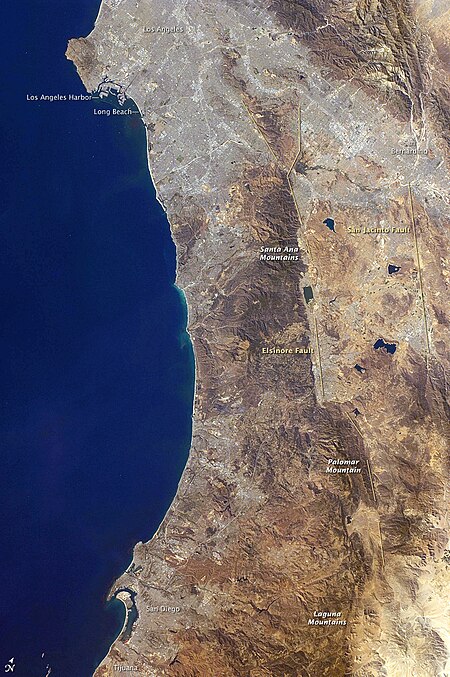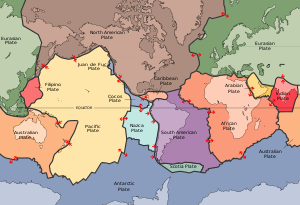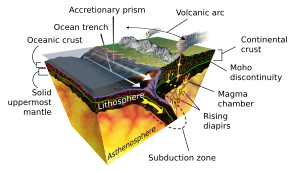Lithosphere
|
Read other articles:

弗雷德里克·齊盧巴Frederick Chiluba第2任赞比亚总统任期1991年11月2日—2002年1月2日副职利维·姆瓦纳瓦萨前任肯尼思·卡翁达继任利维·姆瓦纳瓦萨 个人资料出生(1943-04-30)1943年4月30日北罗得西亚基特韦逝世2011年6月18日(2011歲—06—18)(68歲) 尚比亞卢萨卡(Lusaka)墓地 尚比亞卢萨卡使館公園總統陵園(英语:Embassy Park Presidential Burial)国籍赞比亚政党多黨民主運動(MMD)配…

提示:此条目页的主题不是中華人民共和國最高領導人。 中华人民共和国 中华人民共和国政府与政治系列条目 执政党 中国共产党 党章、党旗党徽 主要负责人、领导核心 领导集体、民主集中制 意识形态、组织 以习近平同志为核心的党中央 两个维护、两个确立 全国代表大会 (二十大) 中央委员会 (二十届) 总书记:习近平 中央政治局 常务委员会 中央书记处 中�…

Il peccato degli anni verdiMarie Versini e Maurice Ronet in una scena del filmLingua originaleitaliano Paese di produzioneItalia Anno1960 Durata87 min Dati tecniciB/N Generesentimentale, drammatico RegiaLeopoldo Trieste SoggettoLeopoldo Trieste SceneggiaturaLeopoldo Trieste ProduttorePasquale Petricca Produttore esecutivoVico Pavoni Casa di produzioneNord Industrial Film Distribuzione in italianoGlobe Films International FotografiaArmando Nannuzzi MontaggioEdmondo Lozzi MusicheIgino Negri, d…

2016年美國總統選舉 ← 2012 2016年11月8日 2020 → 538個選舉人團席位獲勝需270票民意調查投票率55.7%[1][2] ▲ 0.8 % 获提名人 唐納·川普 希拉莉·克林頓 政党 共和黨 民主党 家鄉州 紐約州 紐約州 竞选搭档 迈克·彭斯 蒂姆·凱恩 选举人票 304[3][4][註 1] 227[5] 胜出州/省 30 + 緬-2 20 + DC 民選得票 62,984,828[6] 65,853,514[6] 得…

烏克蘭總理Прем'єр-міністр України烏克蘭國徽現任杰尼斯·什米加尔自2020年3月4日任命者烏克蘭總統任期總統任命首任維托爾德·福金设立1991年11月后继职位無网站www.kmu.gov.ua/control/en/(英文) 乌克兰 乌克兰政府与政治系列条目 宪法 政府 总统 弗拉基米尔·泽连斯基 總統辦公室 国家安全与国防事务委员会 总统代表(英语:Representatives of the President of Ukraine) 总理…

Terraria Официальный логотип игры Разработчики Engine Software[вд], 505 Games и Re-Logic Издатели 505 Games, Re-Logic, Pipeworks Studios[вд] и Spike Chunsoft[вд][1] Локализатор Headup Games[2] Дата анонса 18 апреля 2011[3] Дата выпуска 17 мая 2011 Лицензия проприетарная Последняя версия 1.4.4.9 (30 ноября 2022) …

本表是動態列表,或許永遠不會完結。歡迎您參考可靠來源來查漏補缺。 潛伏於中華民國國軍中的中共間諜列表收錄根據公開資料來源,曾潛伏於中華民國國軍、被中國共產黨聲稱或承認,或者遭中華民國政府調查審判,為中華人民共和國和中國人民解放軍進行間諜行為的人物。以下列表以現今可查知時間為準,正確的間諜活動或洩漏機密時間可能早於或晚於以下所歸類�…

Public policy school of George Washington University George Washington UniversitySchool of Media and Public AffairsMottoDeus Nobis Fiducia (In God Our Trust)TypePrivateEstablished1938Parent institutionColumbian College of Arts and SciencesAcademic staff55 [1]LocationWashington, D.C.CampusUrban—Foggy BottomWebsitesmpa.gwu.edu The School of Media and Public Affairs (SMPA) at the George Washington University in Washington, DC, a school in the Columbian College of Arts and Sciences, offers…

History and regulations of American citizenship This article is about laws for acquiring U.S. nationality. For rights and privileges of citizenship, see Citizenship of the United States. United States citizenship and immigration Immigration Immigration to the United States Emigration from the United States Immigration policy of the United States Effects of immigration to the United States Permanent Residency (Green Card) Refugees and asylum Diversity Immigrant Visa Illegal immigrants Deportation…

Luni-solar calendar This article has multiple issues. Please help improve it or discuss these issues on the talk page. (Learn how and when to remove these template messages) This article needs additional citations for verification. Please help improve this article by adding citations to reliable sources. Unsourced material may be challenged and removed.Find sources: Assamese calendar – news · newspapers · books · scholar · JSTOR (July 2022) (Learn how and…

Ancient Roman fort in Northumberland, England HabitancumSite of Habitancum Roman FortLocation in NorthumberlandLocationCoordinates55°10′12″N 2°10′19″W / 55.170°N 2.172°W / 55.170; -2.172Place nameRisinghamCountyNorthumberlandCountryEnglandReferenceUK-OSNG referenceNY891861 Roman forts in 270 AD Lidar image of Habitancum Habitancum was an ancient Roman fort (castrum) located at Risingham, Northumberland, England. The fort was one of series of built along the ex…

Group of mountain ranges in Southern California and northern Mexico Peninsular RangesSierra San Pedro Mártir and Devils Peak, Southern Baja California, MexicoHighest pointPeakSan Jacinto PeakElevation10,834 ft (3,302 m)GeographyCountriesMexico and United StatesStatesBaja California Sur, Baja California and CaliforniaGeologyAge of rockMesozoicType of rockGranite The Peninsular Ranges (also called the Lower California province[1]) are a group of mountain ranges that stretch…

American college aquatic sports competition 1992 NCAA Division I Swimming and Diving ChampionshipsHost city Indianapolis, IndianaDate(s)March 1992Venue(s)Indiana University NatatoriumIndiana University← 1991 1993 → The 1992 NCAA Division I Men's Swimming and Diving Championships were contested in March 1992 at the Indiana University Natatorium in Indianapolis, Indiana at the 69th annual NCAA-sanctioned swim meet to determine the team and individual national champions of Division I me…

Tubagus Anis Angkawijaya Staf Ahli Sosial Politik KapolriMasa jabatan3 Oktober 2014 – 3 September 2015PendahuluIrjen. Pol. Syahrul MammaPenggantiBrigjen. Pol. Basaria PanjaitanAsisten Sarana dan Prasarana KapolriMasa jabatan6 Desember 2013 – 3 Oktober 2014PendahuluIrjen. Pol. Anton Bachrul AlamPenggantiIrjen. Pol. Erry SubagyoKepala Divisi TI PolriMasa jabatan12 Juni 2013 – 6 Desember 2013PendahuluIrjen. Pol. Muhammad Amin SalehPenggantiBrigjen. Pol. Achmad Hiday…

WWE Hall of Fame induction ceremony WWE Hall of Fame (2009)The WWE Hall of Fame Class of 2009 and their inductorsPromotionWWEDateApril 4, 2009CityHouston, Texas[1]VenueToyota CenterWWE Hall of Fame chronology ← Previous2008 Next →2010 WWE Hall of Fame (2009) was the event which featured the introduction of the 10th class to the WWE Hall of Fame. The event was produced by World Wrestling Entertainment (WWE) on April 4, 2009, from the Toyota Center in Houston, Texas. The even…

Sporting event in Leipzig, Germany 2003 European Athletics Indoor CupHost cityLeipzig, GermanyEvents19Dates15 FebruaryMain venueArena Leipzig2004 Leipzig → The host stadium for the event in Leipzig The 2003 European Athletics Indoor Cup was held on 15 February 2003 at the Arena Leipzig in Leipzig, Germany.[1] It was the inaugural edition of the indoor track and field meeting for international teams, which featured the eight top performing nations from the 2002 European Cup. …

This article has multiple issues. Please help improve it or discuss these issues on the talk page. (Learn how and when to remove these template messages) This article needs to be updated. Please help update this article to reflect recent events or newly available information. (December 2013) This article's lead section may be too short to adequately summarize the key points. Please consider expanding the lead to provide an accessible overview of all important aspects of the article. (January 202…

Voce principale: Promozione 1976-1977. Promozione1976-1977 Competizione Promozione Sport Calcio Edizione 3ª Organizzatore FIGC - LNDComitato Regionale Trentino-Alto Adige Luogo ItaliaTrentino-Alto Adige Partecipanti 16 Cronologia della competizione 1975-1976 1977-1978 Manuale Nella stagione 1976-1977 la Promozione era il quinto livello del calcio italiano (il massimo livello regionale). Qui vi sono le statistiche relative al campionato in Trentino-Alto Adige. Il campionato è strutturato …

الدوري الإنجليزي لكرة القدم 2017–18 تفاصيل الموسم دوري كرة القدم الإنجليزية البلد المملكة المتحدة البطل وولفرهامبتون واندررز الدوري الإنجليزي لكرة القدم 2016–17 دوري كرة القدم الإنجليزي 2018–19 تعديل مصدري - تعديل الدوري الإنجليزي لكرة القدم 2017–18 هو موسم من �…

2003 single by Foo FightersHave It AllStandard artworkSingle by Foo Fightersfrom the album One by One B-sideDarling NikkiReleasedSeptember 22, 2003 (2003-09-22)RecordedMay 2002Length4:58LabelRoswell/RCASongwriter(s) Dave Grohl Taylor Hawkins Nate Mendel Chris Shiflett Producer(s) Foo Fighters Nick Raskulinecz Foo Fighters singles chronology Low (2003) Have It All (2003) Best of You (2005) Have It All was the fourth and final single to be released off the Foo Fighters' fourth album…






